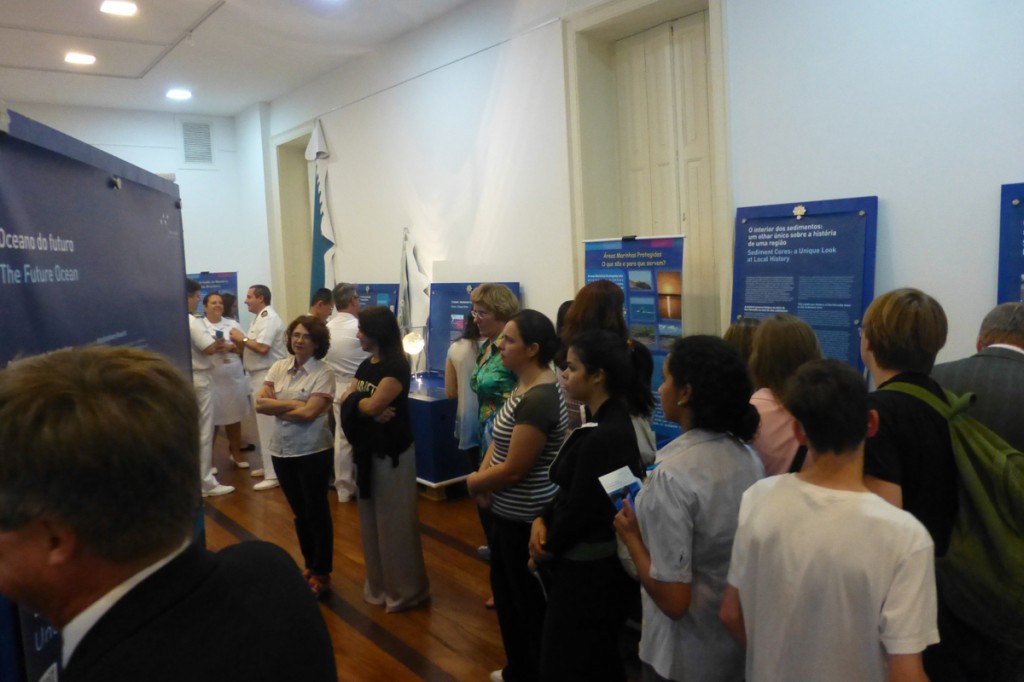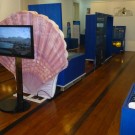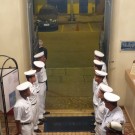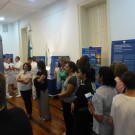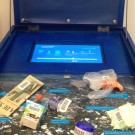German version: See below
One week Rio de Janeiro! I had hoped that this week would leave me with many impressions but certainly not so many. I arrived Thursday night, happy to finally get a sniff of the South American air again with a little time the next day to acclimatize and to fully focus on football (Image 1).
Rarely have I heard so many people of different nations celebrating peacefully together, dancing and singing at the Copacabana after Germany and Brazil had qualified for the semi-finals. One could admire samba, salsa and cumbia dancers from all over South America, coupled with the rhythmic “Schlaaaand” call of the Germans and all set against the wonderful ambience of the Atlantic. I must say I was a bit surprised at how many beautiful city beaches there are in Rio de Janeiro, a city with a profound connection to the sea, a wonderful place for the second stage of the mobile exhibition of the “Future Ocean”.
First, before the exhibition opening on Monday, everything had to be checked again for functionality: the video presentations and the interactive monitors (Image 2). Since I hadn’t yet seen the exhibition, I had to first familiarize myself with some things.
On Monday the opening of the exhibition took place, at which Vice-Admiral Armando de Senna Bittencourt, who is also the director of the museum, Joachim Schemel, the Vice-Consul of the German Embassy in Rio de Janeiro, as well as from Christian Müller, head of the DAAD in Brazil all made some introductory remarks. In addition to the beautiful ambience of the “Naval Museum” in Rio de Janeiro, the guests were also able to enjoy the sight of marines in white uniforms at the reception (Image 3).
At the opening, in addition to representatives of the Navy, many scientists and students were very impressed by the different themes of the exhibition (Image 4). I think that the “plastic waste in the oceans” module made a particularly lasting impression because many people are not aware of how long plastic garbage takes to decompose (up to 500 years) and how bad the plastic waste pollution problem is. (Image 5).
On Wednesday, Prof. Dr. Leticia Cotrim da Cunha from the University of Rio de Janeiro and I each gave talks at the Navy Museum by on oxygen minimum zones in the oceans and ocean acidification. These talks were part of the lecture series “German-Brazilian Lectures on Climate Change Effects on the Oceans”. The lecture series was surprisingly well attended, in spite of the semi-final between Brazil and Germany having taken place a day before, which we all know how it turned out.
That evening for a short time the dancing and singing stopped in the city. I had never seen Rio de Janeiro as quiet as on this evening. It was all the more beautiful was to see that the Brazilians did not take too long to return back to their natural happiness and most of their energy from then on was used in cheering for the German team.
All in all, it was an incredible week with lots of great impressions and conversations, even if I have to say that I was finally glad to be back in Germany for the final. For can you celebrate being World Champions (!!!) as in your own country.
Patricia Grasse
- Photo: Patricia Grasse
- Photo: Christian de Lamboy
- Photo: Christian de Lamboy
- Photo: Christian de Lamboy
- Photo: Christian de Lamboy
—
1 Woche Rio de Janeiro! Ich hatte schon erhofft, dass mich in dieser Woche viele Eindrücke erwarten, aber sicherlich nicht so viele. Nachdem ich Donnerstag in der Nacht angekommen war, glücklich endlich mal wieder südamerikanische Luft zu schnuppern, hatte ich den nächsten Tag noch etwas Zeit, mich zu akklimatisieren und den Tag vollends dem Fußball zu widmen!
Selten habe ich so viele Menschen unterschiedlicher Nationen so friedlich zusammen feiern, tanzen und singen hören wie an der Copacabana nachdem Deutschland und Brasilien sich für das Halbfinale qualifiziert hatten. Man konnte Samba, Salsa und Cumbia Tänzer aus ganz Südamerika bewundern, gepaart mit rhythmischen „Schlaaaand“-Rufen der Deutschen und all das vor dem wunderbaren Ambiente des Atlantik. Ich muss sagen, ich war etwas überrascht, wie viele schöne Stadtstrände es in Rio de Janeiro gibt. Eine Großstadt mit einer tiefen Bindung zum Meer, ein wundervoller Ort für die zweite Etappe der mobilen Ausstellung des „Future Ocean“.
Zunächst musste vor der Ausstellungeröffnung am Montag noch einmal überprüft werden, ob auch alles voll funktionsfähig ist, die Videopräsentationen laufen und auch die interaktiven Monitore funktionieren. Da ich selber die Ausstellung auch noch nicht gesehen hatte, musste auch ich mich erstmals mit einigen Dingen vertraut machen.
Am Montag fand dann die Eröffnung der Ausstellung statt, bei der auch einleitende Worte vom Vize-Admiral Armando de Senna Bittencourt, der gleichzeitig der Direktor vom Museum ist, von Joachim Schemel, dem Vize-Konsul der deutschen Botschaft in Rio de Janeiro, sowie Christian Müller, dem Leiter des DAAD in Brasilien, gesprochen wurden. Neben dem wunderschönen Ambiente des “Museu Naval” in Rio de Janeiro, kamen die Gäste auch in den Genuss, von Marinesoldaten in weißen Uniformen in Empfang genommen zu werden.
Bei der Eröffnung waren neben Repräsentanten der Marine auch viele Wissenschaftler und Studenten, die alle äußert begeistert waren von den unterschiedlichen Themen der Ausstellung. Ich denke besonders nachhaltigen Eindruck hat die Themenbox „Plastikmüll in den Weltmeeren“ gemacht, da vielen Menschen doch nicht bewusst ist, wie lange Plastikmüll braucht, um sich zu zersetzen (bis zu 500 Jahren) und wie groß die Verschmutzung mit Plastikmüll ist.
Am Mittwoch wurden dann noch im Marine Museum zwei Vorträge von mir und Prof. Dr. Leticia Cotrim da Cunha von der Universität in Rio de Janeiro gehalten über Sauerstoffminimum Zonen in den Weltmeeren und Ozeanversauerung. Den Rahmen bildete die Veranstaltung „ German-Brazilian Lectures on Climate Change Effects on the Oceans“. Die Vortragsreihe war erstaunlich gut besucht, dafür, dass ein Tag zuvor das Halbfinale Deutschland gegen Brasilen stattfand, von dem wir ja alle wissen, wie es ausgegangen ist. An diesem Abend hörte die Stadt auch für kurze Zeit auf zu tanzen und zu singen. Ich hatte Rio de Janeiro noch nie so ruhig gesehen wie an diesem Abend. Umso schöner war es zu sehen, dass die Brasilianer nicht allzu lange brauchten, um zu ihrer eigentlichen Fröhlichkeit zurück zu kehren und die meisten ihre Energien von da an nutzten, das deutsche Team anzufeuern.
Alles in allem, war es eine unglaubliche Woche mit vielen tollen Eindrücken und Gesprächen, auch wenn ich sagen muss, dass ich letztendlich froh war, zum Finale wieder in Deutschland zu sein. Denn wo kann man schöner feiern Weltmeister (!!!) zu sein, als im eigenen Land.
Patricia Grasse
